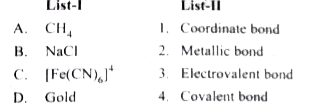Explain the bond formation in SF4andCCl_(4)' using hybridisation concept.Solution in Tamil
In SF4, the central atom is sp3 d hybridised.
he molecule SF4 will have a total 34 valence electron: 6 from sulpur, 7 each from four fluorine atoms.
Sulphur atom will from 4 single bonds with fluorine atoms. These bonds account for the 8 electrons out of the 34 valence electrons. Each fluorine atom will have 3 1one pair of electrons in order to have a complete octet structure. These lone pairs will use up 24 valence electrons. So the total used valence electrons, are 32. The remaining 2 electrons will be placed on the sulphur atom as a lone pair.

Sulphur atom gets a total of 10 electrons 8 from the bonds and 2 as lone pair. This is quite possible for sulphur because it has easy access to its 3d orbital which means that it can expand its octet and accommodate more than 8 electrons.
Sulphur forms 4 single bonds and has 1 lone pair which means that its steric number is equal to 5. In this case sulphur will use five hybrid orbitals, such as one 3s orbital three 3p orbitals and one 3d orbital. So the central atom is sp3d hybridised.
(ii) CC14
It is not necessary to invoke hybridisation especially in CC14. It must be invoked for all tetrahedral bonds of carbon and other atoms.
The electronic configuration of an isolated carbon atom in its ground state is 1s2 2s2 2p2.
CC1)(4) is a tetrahedral molecule comprising of four single bonds known as signa bonds between the carbon atom and the chlorine atoms. In this type of bonding, the 2s orbital and three 2p orbitals of carbon atoms are mixed to produce four identical orbitals, a process known as sp3hybridisation. 
Topper's Solved these Questions
- CHEMICAL BONDING Book:FULL MARKSChapter:CHEMICAL BONDING Exercise:ADDITIONAL QUESTIONS SOLVED (CHOOSE THE CORRECT ANSWER.)
Explore 50 Videos
- CHEMICAL BONDING Book:FULL MARKSChapter:CHEMICAL BONDING Exercise:ADDITIONAL QUESTIONS SOLVED (MATCH THE FOLLOWING.)
Explore 11 Videos
- CHEMICAL BONDING Book:FULL MARKSChapter:CHEMICAL BONDING Exercise:TEXTUAL EVALUATION SOLVED (SHORT ANSWER QUESTIONS.)
Explore 25 Videos
- BASIC CONCEPTS OF ORGANIC REACTIONS Book:FULL MARKSChapter:BASIC CONCEPTS OF ORGANIC REACTIONS Exercise:Additional Questions Solved (5-Marks Question)
Explore 10 Videos
- ENVIRONMENTAL CHEMISTRY Book:FULL MARKSChapter:ENVIRONMENTAL CHEMISTRY Exercise:ADDITIONAL QUESTIONS SOLVED ( 5-Mark Questions )
Explore 8 Videos
Similar Questions
Which is the correct Lewis structure of Helium?
View SolutionMatch the following columns

View SolutionDefine the following: (i) Bond order (ii) Hybridisation (iii) σ -bond
View SolutionExplain electron movement in organic reactions.
View SolutionExplain about the different layers of Earth's atmosphere
View SolutionThe hybridisation of sulphur in SF_(4) is
View SolutionDescribe hybridisation in the case of PCl5andSF6 The axial bonds are longer as compared to equatorial bonds in PCl5 whereas in SF6 both axial bonds and equatorial bonds and have the same bond length. Explain.
View SolutionExplain why all bonds in SF_(4) molecule are not equivalent.
View SolutionPredict hybridisation and shape of SF4 molecule.
View SolutionHow many hybrid orbitals are used for bond formation in SF_(4) ?
View SolutionCCl_(4) is also used as a __________.
View SolutionExplain the hybridisation involved is SF6.
View SolutionExplain the bond formation in SF4 and CCl4 using hybridisation concept.
SF4
View SolutionExplain the bond formation in SF4 and CCl4 using hybridisation concept.
CCl4
View SolutionWhich type of hybridisation explain the trigonal bipyramidal shape of SF4?
View Solution

